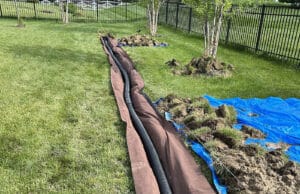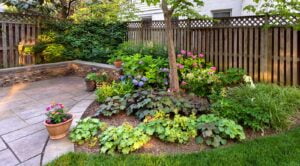When the temperature drops, the serene beauty of frosty landscapes comes with a hidden threat to hardscapes and stone patios: water. The damage caused by freezing and thawing cycles can lead to cracks, shifting, and long-term structural issues in your outdoor spaces. Understanding how freezing water affects hardscapes and implementing preventative measures can save you costly repairs and preserve your patio’s durability for years to come.
The Science Behind the Damage
Water expands by approximately 9% when it freezes. This expansion creates significant pressure on surrounding materials. For hardscapes and stone patios, the problems arise when water infiltrates small cracks, gaps, or porous surfaces. As the water freezes, it exerts force on the stone, concrete, or pavers, causing cracks to widen or new fractures to form. Repeated freeze-thaw cycles exacerbate this damage, leading to crumbling edges, uneven surfaces, and even complete structural failure in severe cases.
Common Vulnerabilities in Hardscapes
- Porous Materials: Natural stones, such as sandstone and limestone, tend to be more porous and are particularly susceptible to water absorption and freeze-thaw damage.
- Improper Installation: Poor drainage or insufficiently compacted bases can trap water beneath pavers, leading to frost heaving—a process where freezing water pushes materials upward.
- Cracks and Gaps: Small imperfections in stone or concrete can allow water to seep in and wreak havoc during freezing weather.
- Inadequate Sealing: Without proper sealing, even non-porous surfaces can absorb water over time.
Preventative Measures to Protect Your Hardscapes
Ensure Proper Drainage
- Design your patio or hardscape with a slight slope to channel water away.
- Install drainage solutions like French drains or permeable pavers to prevent water accumulation.
Use High-Quality Materials
- Opt for denser, less porous materials such as granite or bluestone.
- Consider engineered products like concrete pavers designed to resist freeze-thaw cycles.
Seal Your Surfaces
- Apply a water-repellent sealer annually or as recommended by the manufacturer to reduce water infiltration.
- Use breathable sealers that allow trapped moisture to escape without compromising protection.
Fill Cracks Promptly
- Inspect your hardscapes regularly for cracks or gaps.
- Use a durable, weather-resistant filler to repair any damage before winter arrives.
Elevate and Insulate
- Install your hardscapes with a properly compacted base of crushed stone to enhance drainage.
- Add a layer of insulation, such as geo-textile fabric, beneath pavers to minimize frost heaving.
Clean and Maintain Regularly
- Remove debris and dirt from your patio to prevent clogging of drainage channels.
- Avoid using harsh chemicals or de-icing salts, which can deteriorate stone surfaces.
The Benefits of Preventative Care
Investing time and effort into protecting your hardscapes ensures they remain visually appealing and structurally sound for years. Beyond aesthetics, well-maintained patios and stone features add value to your home and create functional, enjoyable outdoor spaces that withstand seasonal challenges.
The experts at Shorb Landscaping can help you take the necessary steps to address potential freeze-thaw damage, so you can keep your hardscapes looking pristine and reduce costly repairs. A little foresight and regular maintenance go a long way in preserving the beauty and functionality of your stone patios through even the harshest winters.







